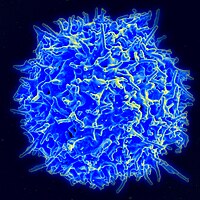
Photo from wikipedia
The field of mucosal-associated invariant T cell (MAIT) biology has grown rapidly since the identification of the vitamin-B-based antigens recognised by these specialised T cells. Over the past few years,… Click to show full abstract
The field of mucosal-associated invariant T cell (MAIT) biology has grown rapidly since the identification of the vitamin-B-based antigens recognised by these specialised T cells. Over the past few years, our understanding of the complexities of MAIT cell function has developed, as they find their place among the other better known cells of the immune system. Key questions relate to understanding when MAIT cells help, when they hinder or cause harm, and when they do not matter. Exploiting mouse strains that differ in MAIT cell numbers, leveraged by specific detection of MAIT cells using MR1-tetramers, it has now been shown that MAIT cells play important immune roles in settings that include bacterial and viral infections, autoimmune diseases and cancer. We have also learnt much about their development, modes of activation and response to commensal microbiota, and begun to try ways to manipulate MAIT cells to improve disease outcomes. Here we review recent studies that have assessed MAIT cells in models of disease.
Journal Title: Molecular immunology
Year Published: 2020
Link to full text (if available)
Share on Social Media: Sign Up to like & get
recommendations!